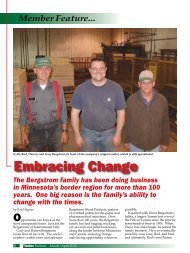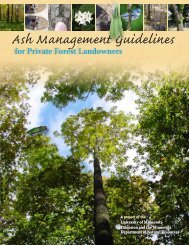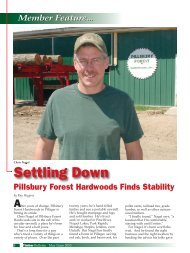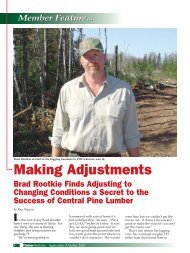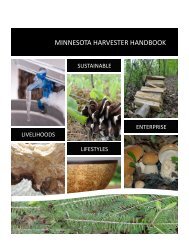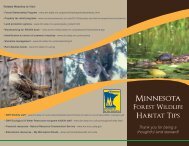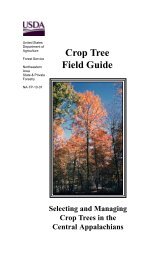Ash Management Guide for Private Forest Landowners
Ash Management Guide for Private Forest Landowners
Ash Management Guide for Private Forest Landowners
You also want an ePaper? Increase the reach of your titles
YUMPU automatically turns print PDFs into web optimized ePapers that Google loves.
Photo: Bill SwindamanChapter 1A History of Minnesota’s<strong>Ash</strong> ResourceThe habitat of the green heron issmall wetlands in low-lying areas.The species is most conspicuousduring dusk and dawn. They preferto be active at night, retreatingto sheltered areas during thedaytime.arrived in the state, ash was a componentof roughly 1,221,000 acres of <strong>for</strong>est land.Some 902,000 of these acres were directlylost to conversion of the land to somethingother than <strong>for</strong>est. However, thisloss is partially offset by a gain of 548,000acres where <strong>for</strong>ests lacking ash were convertedto types with ash.On land that has been <strong>for</strong>estthroughout the settlement period, therelative abundance of ash to other treeshas gone up from 1.5 percent of <strong>for</strong>estland trees to 8.5 percent– nearly sixtimes its historic abundance. These gainshave occurred almost exclusively in habitatswhere ash is dominant. The acreageof monotypic ash <strong>for</strong>est has increasedfrom 229,000 to about 406,000 acres.Why? <strong>Ash</strong> was excluded from habitatswhere fire was a chronic influence. Firesuppression has undoubtedly allowedash to increase in Minnesota’s westernand southeastern <strong>for</strong>ests. But this doesn’texplain the shift to monotypic <strong>for</strong>est.More likely is the fact that swamps arenot prime real estate or agricultural land.Uplands were developed leaving richblack ash, tamarack, and cedar swamps,undeveloped but not untouched.Tamarack and cedar were heavilyexploited during settlement <strong>for</strong> railroadties and rot-resistant building materials –while ash was “good firewood.”In addition, Minnesota’s tamarackpopulation was devastated by Europeanlarch sawflies between 1900 and 1950.Apparently, Minnesota’s rich swamp<strong>for</strong>ests with ash were left alone, and manywith tamarack and cedar have succeededto pure ash. In recent times, tamarackand cedar have shown little natural abilityto regenerate in rich swamps.GLOSSARYmonotypic: Referring toconservation biology andsuccessional changes leading toa single species.9



